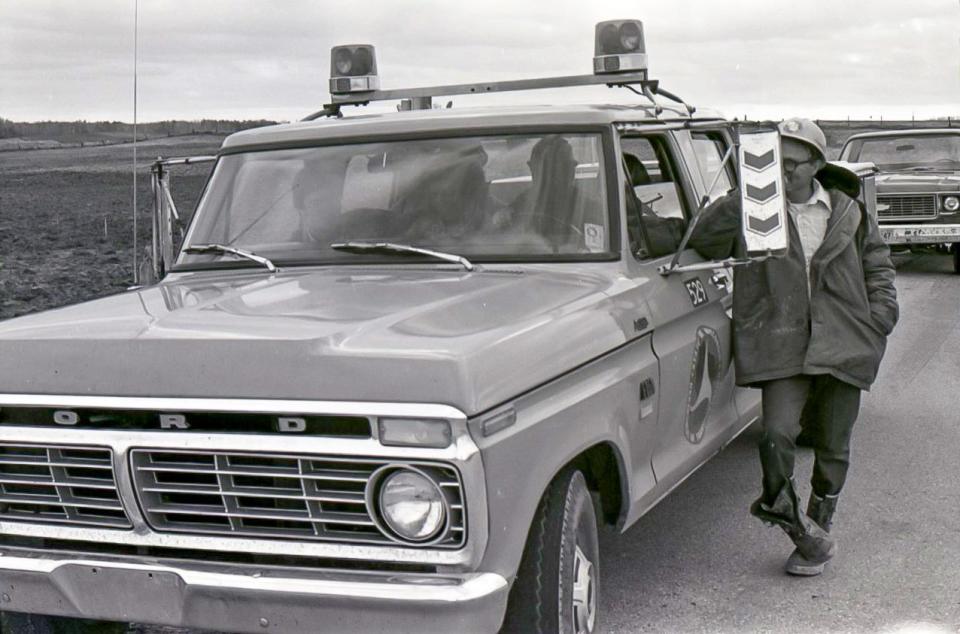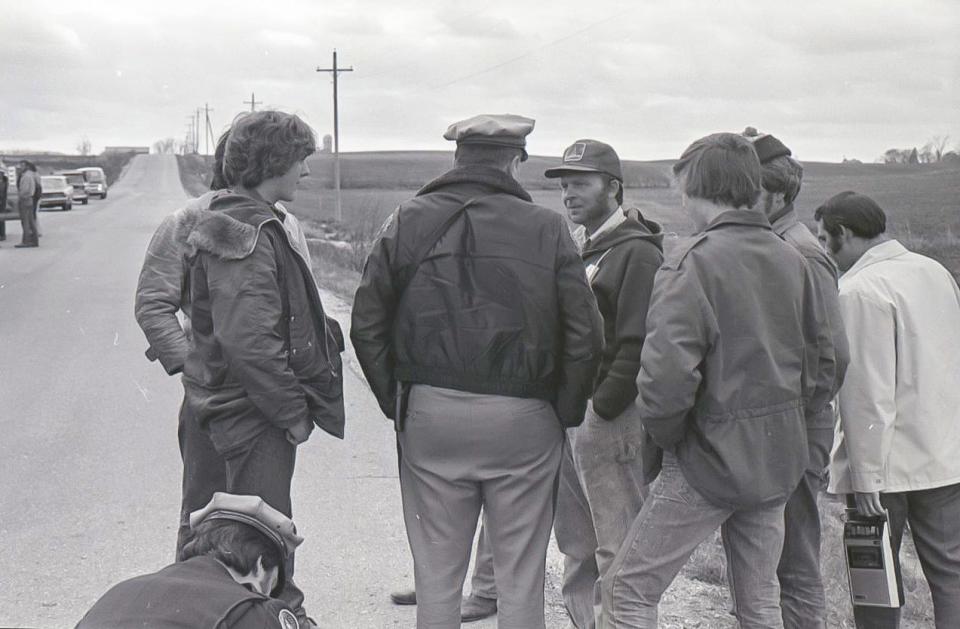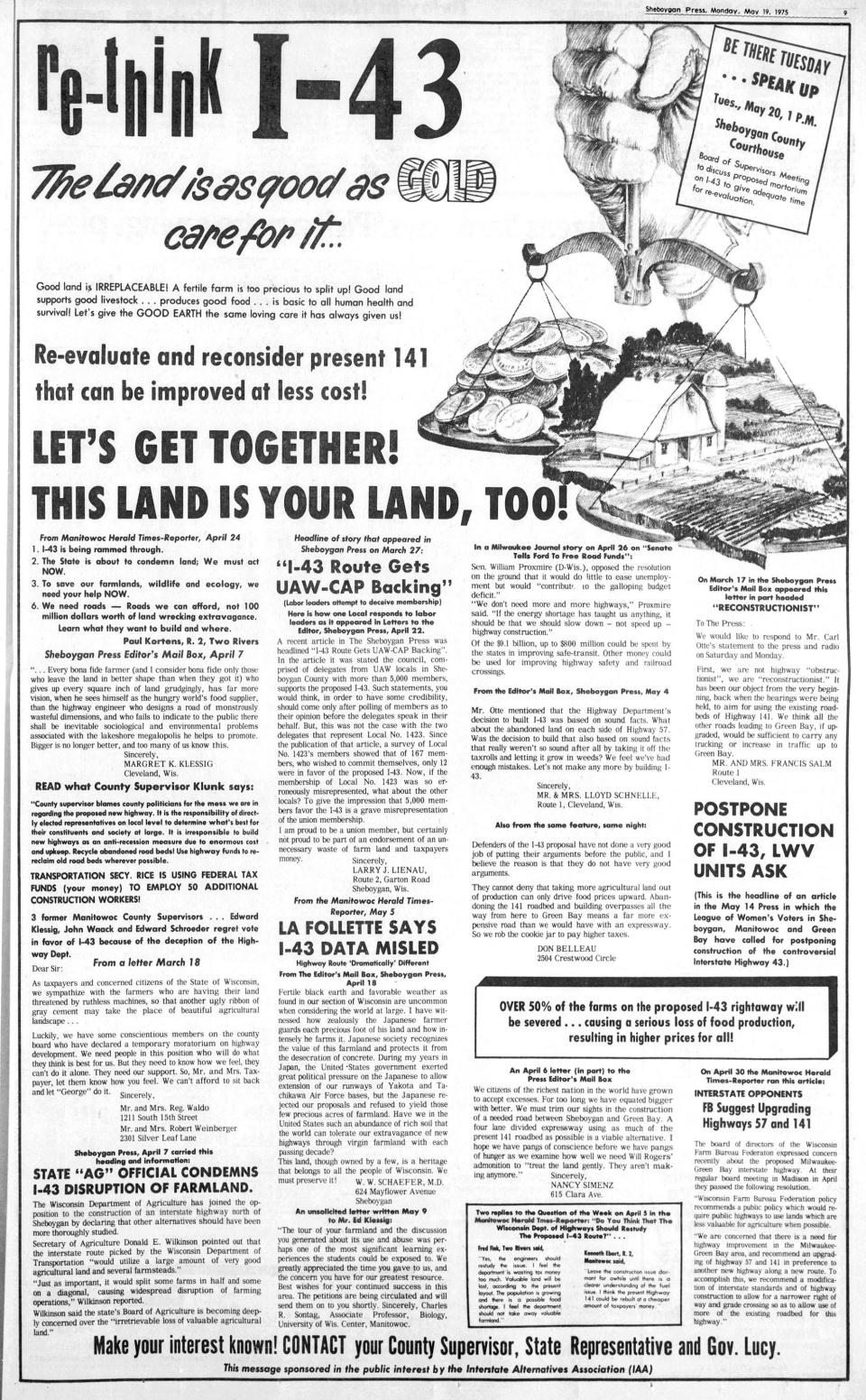‘Cow-in’ and protesting nuns: A look back at the 1970s fight against I-43 in Manitowoc and Sheboygan counties
Correction: This story has been updated from an earlier version to state Anthony Dufek as mayor of Manitowoc.
SHEBOYGAN - Farmers along the corridor of what is now Interstate 43 in Sheboygan and Manitowoc counties battled the state in the 1970s on exactly where to build a four-lane interstate that would extend to Green Bay.
The farmers, led by Cleveland's Ed Klessig, wanted the existing U.S. 141 converted to an expressway instead. Klessig's group felt construction of the interstate would be a needless land-grab by the Wisconsin Department of Transportation, retired Sheboygan Press reporter Robert Bushner said.
The group claimed acres of prime farmland would be destroyed in the path of the new interstate.
To see the slider larger, click here.
Plans began in 1971 for a route that would go from Sheboygan to Green Bay. Farmers and homeowners along were alarmed on many fronts for the project. Farmers also complained about the uneven payouts from the state for their farmland. Some farmers received as little as $600 an acre and some got nearly $2,000 and acre for their land. Homeowners were alarmed they might lose their homes.
According to Bushner, the anti-interstate group tried in vain to have the state's eminent domain law changed to more fairly reimburse landowners affected by highway construction, an effort that was eventually changed years later during a heated battle by other protesters over construction of a new State 23.

The new interstate highway would be built using federal funds paying for 90% of the cost. If the plans went through to make an expressway on then-current U.S. 141, the funding would then be at only 70%.
The protests began.
According to Bushner, "On one occasion in Manitowoc County, the demonstrators — led by the fiery Klessig and a band of an unlikely group of Franciscan nuns — climbed over piles of mud in a futile effort to stop the huge dirt-movers and halt the construction."
According to a Sheboygan Press clipping, some 12 protesters were arrested and released from jail when they paid the $50 for their bail.

But it didn't stop there.
The protest groups bought a full page in the Sheboygan Press to detail why the highway should be built along the existing U.S. 141 route. The page claimed the land was as good as gold and urged officials to re-think the plans.

According to a Jim Stingl column in the Milwaukee Journal Sentinel about Margaret Klessig and her late husband Edward, in the pre-dawn hours of April 20, 1976, he unloaded three cows and a calf from a trailer and put them in a tent and makeshift corral on the Capitol lawn outside Gov. Patrick Lucey's office. Edward and daughter Elise and other protesters lived in a second tent. The "cow-in" lasted 30 days and collected thousands of names on petitions.
"We gave away the milk to people. We milked the cows, morning and night," Elise recalled.
Many thought the Klessig complaint was centered on the state land-grab. However, retired Sheboygan Press City Editor Joe Gulig said, "I recall Klessig talking exclusively about the environmental and economic impact of losing valuable farmland to road construction when use of existing highway right-of-way (Highway 57 or Highway 141) would require taking less farmland."
Freeway foes would refuse to cash checks issued from the state for their land. In 1976, new checks appeared after Circuit Court Judge Allen Deehr signed a petition ordering payment. The judge had earlier dismissed a lawsuit on the behalf of 39 people who challenged condemnation actions by WisDOT in taking land for the I-43 project.
Later, Federal District Judge James Doyle would hear the case challenging the environmental impact study of the road.
Construction on the area interstate started in 1972 and was finished in 1981. When the project was finally fully approved, the medians were cut to 60 feet wide instead of 84 feet wide to use use less land, yet stay within interstate standards. That move was claimed to save at least 100 acres of farmland, according to UW-Green Bay.
In 1975, the Sheboygan Press ran an editorial about the I-43 go-ahead. The article said construction between Sheboygan and Green Bay would begin in earnest in 1976.
Related Throwback: Downtown Sheboygan Falls' Broadway Street had dirt roads and wooden sidewalks
The editorial said Interstate 43 between Sheboygan and Green Bay was estimated to cost $87.4 million with the federal government picking up 90% of the cost. Had the road been deemed an expressway by converting U.S. 141, the cost would have been $85.6 million with the federal government only picking up 70% of that cost. The interstate would cost taxpayers less and provide a safer highway, according to the editorial.
In the end, according to the Press, an analysis on the location we see today would consume about 2,000 acres of farmland from 11 farms, 22 homes and one business. The U.S. 141 Expressway alternative would consume 188 homes, 33 businesses and 49 farms.
A special ceremony was held Oct. 10, 1981, during which Sheboygan Mayor Richard Suscha, Green Bay Mayor Sam Halloin, Manitowoc Mayor Anthony Dufek, and Donald Harden, associate chancellor at the University of Wisconsin-Green Bay, along with Roger Vanden Langenbert, chairman of the town of Bellevue, assembled at four locations on the new road to celebrate its completion.
So the next time you take a trip to Manitowoc or go to Green Bay to catch a Packers game, you will travel on a road had plenty of bumps along the way before completion.
This article originally appeared on Sheboygan Press: Interstate 43 in Manitowoc, Sheboygan came despite protests by farmers

